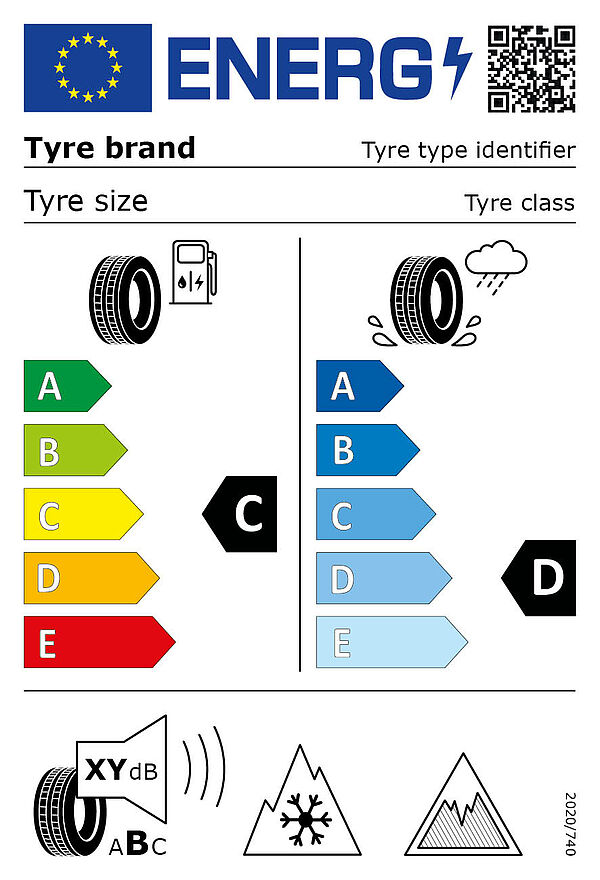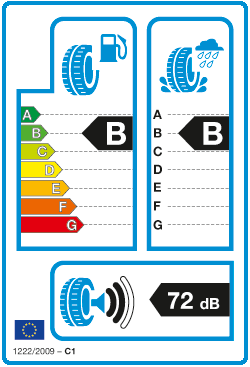
By launching its revised tyre labelling regulation and its
and offering the option of two new performance indicators (snow and ice grip), the European Commission intends to provide better information to consumers buying tyres, to support them in their decisions, and to enhance their awareness for tyres delivering the best safety and environmental performance.What’s new and important for you – summarised in a video clip
Source: Continental Reifen Deutschland GmbH

The new EU tyre label helps consumers to decide in favour of a higher fuel efficiency class for their tyres. This can contribute to large reductions in running costs and emissions. Enhanced wet grip means greater road safety, and details of external rolling noise contributes to a reduction in traffic noise levels.
The actual fuel savings and road safety depend heavily on the behaviour of drivers, and in particular on the following:
Ice grip tyres are specifically designed for road surfaces covered with ice and compact snow, and should only be used in very severe climate conditions (e.g. cold temperatures).
Using ice grip tyres in less severe climate conditions (e.g. wet conditions or warmer temperatures) could result in sub-optimal performance, in particular for wet grip, handling, and wear.

Energy label
The EU has introduced energy (efficiency) labels for a great many products. Whereas the tyre label covers performance criteria in addition to energy and fuel efficiency, it nevertheless falls under the energy efficiency category. By retitling this label, the Commission intends to safeguard a common layout for all energy labelled products.

QR code
The QR code on the label contains a direct link to the product in the EPREL database. Here you can retrieve the label and product information sheet for each of the tyres registered. EPREL (European Product Registry Labelling) is a European database for energy labelled products.

The tyre type identifier is the manufacturer’s internal article number. In other words, all tyres of this type have the same construction and deliver the same performance.
The tyre label assigns the tyre classes:

Fuel efficiency class
Less rolling noise saves fuel and cuts CO2. This property is assigned to classes A to E.

Wet grip class
Wet grip is assigned to classes A to E. Wet grip is crucial to safe driving. For instance, the difference between class A and class E braking distances is 18 m.

External rolling noise class
The label presents the volume in dB and the class A (quieter), B, or C (louder). The noise emitted by tyres affects the total noise levels emitted by the vehicle.

Snow grip
The snowflake symbol confirms that the snow tested tyre keeps within the 3PMSF limits (type approval).

Ice grip
The ice symbol confirms that the tested tyre braking on ice keeps within an ISO limit set for a standard reference tyre.
>>> REGULATION (EU) 2020/740 OF THE EUROPEAN PARLIAMENT AND OF THE COUNCIL on the labelling of tyres with respect to fuel efficiency and other parameters, amending Regulation (EU) 2017/1369 and repealing Regulation (EC) No 1222/2009
Tyres produced before 1 May 2021 bear the former tyre label set down in EU Regulation 1222/2009. These need not be relabelled by their manufacturers.
No, the label design has no effect on the tyre properties or the tyre price.



The EU tyre label helps consumers to decide in favour of a higher fuel efficiency class for their tyres. This can contribute to large reductions in running costs and emissions. Enhanced wet grip means greater road safety, and details of external rolling noise contributes to a reduction in traffic noise levels.
The actual fuel savings and road safety depend heavily on the behaviour of drivers, and in particular on the following:

Less rolling noise saves fuel and cuts CO2. This property is assigned to classes A to E.

Wet grip is assigned to classes A to E. Wet grip is crucial to safe driving. For instance, the difference between class A and class E braking distances is 18 m.

The label presents the volume in dB and the class A (quieter), B, or C (louder). The noise emitted by tyres affects the total noise levels emitted by the vehicle.

The snowflake symbol confirms that the snow tested tyre keeps within the 3PMSF limits (type approval).